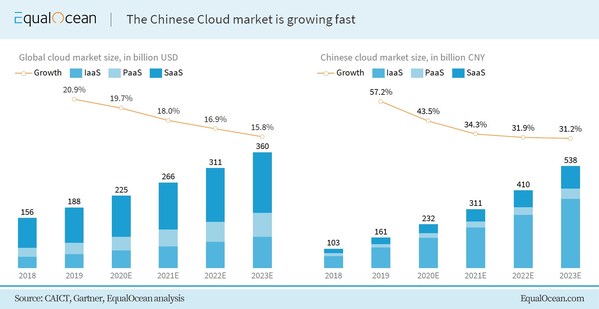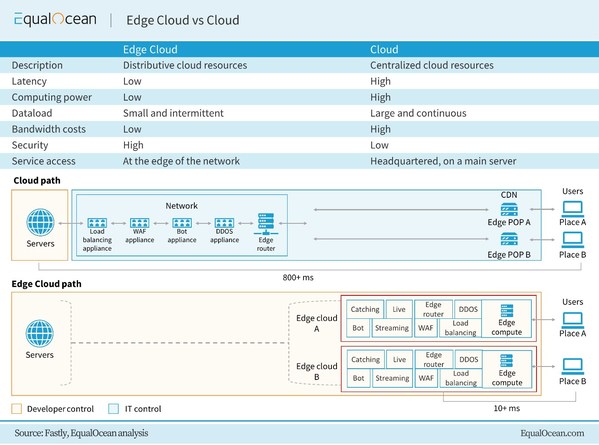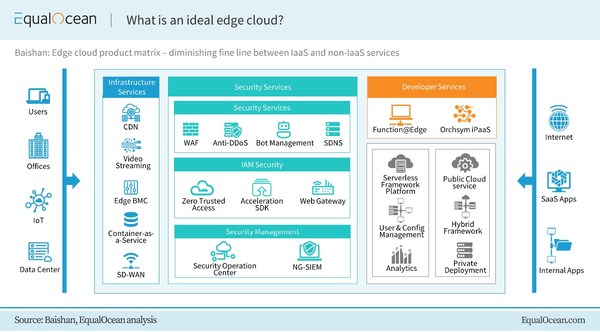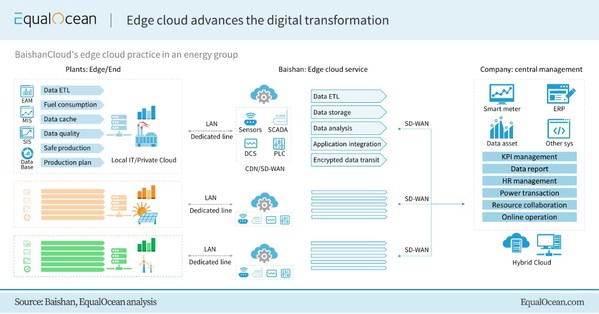A Glimpse into China's Burgeoning Edge Cloud Market
BEIJING,April 7,2021 -- A report by EqualOcean on China's burgeoning edge cloud market:
According to CNNIC,a national IT think tank,China had more than 989 million Internet users by the end of 2020,accounting for approximately 70% of the country's total population,whereas the figure only stood at 909 million a year ago. The COVID-19 crisis has clearly contributed to an accelerated penetration rate of Internet users in China. The user behavior changes have not only burdened the workload of the network but,at the same time,further inspired the development of the cloud industry.
From cloud to 'edge cloud'
Compared with the global market,China's cloud landscape is primarily led by the Infrastructure-as-a-Service (IaaS) segment. Dominated by the public cloud service and IDC service providers,the rising IaaS has developed several verticals to meet the evolving needs: cloud security,content distribution network (CDN),docker,cloud storage and so on. Simultaneously,innovative technologies such as AI and those enabling the Internet of Things (IoT) urged the cloud providers to adapt to the scaling technology deployment; edge computing came into the public sight. As estimated by GSMA,connected devices may reach 24.6 billion by 2025 while the IoT market size may exceed USD 1.1 trillion at the same time.

EqualOcean: The Chinese Cloud market is growing fast
Standing for a decentralized form of cloud computing,the so-called 'edge' networks can promptly respond to regional service requests. Forecasted by MarketsandMarkets,the edge computing market size is expected to grow from USD 3.6 billion in 2020 to USD 15.7 billion by 2025 (a 34.1% CAGR). Driven by the expansion of IoT applications and increasing network traffic and low-latency processing demands,edge computing is appreciated for strengths like a fast response,higher efficiency and improved security.
Edge computing is at an early development phase,and pioneers in the field are mostly found to be network service providers,along with CDN vendors. CDN is a geographically distributed group of services that provides fast delivery of content. The services aim to provide a smoother Internet experience for users via storing cached contents at the end servers,instantly responding to nearby users' visiting requests. Thanks to their decentralized nature,CDN companies are inherently fitted to explore edge computing practice.
CDN transcends to edge computing and edge cloud in China
In the US,leading CDN players such as Cloudflare and Fastly are in the front of the edge cloud business. CDN's Point of Presence (PoP) and the capability to allow users to define their use of the CDN lay a foundation for the edge cloud business. Fastly has determined to dive into the edge cloud business as an extensive IoT future is foreseeable and edge computing demand will rise with the scaling deployment of IoT.
Echoing the US edge cloud market,the domain in China is also led by public cloud providers as well as CDN players. In China,the CDN market is dominated by major public cloud providers,including Alibaba Cloud and Tencent Cloud,Huawei Cloud and traditional CDN companies ChinaNetCenter and BaishanCloud. Due to the trending of the 'Mobile Internet' and ICT technology upgrades,the CDN business has advanced. While AI,IoT and Industrial Internet started to be adopted in China,the change in business demand prompted the emergence of edge computing and cloud companies,as these began to shape their profiles in the field.
Currently,some take edge cloud as a nice-to-have business while others choose to go all-in with edge cloud. China's public cloud market size has been scaling rapidly and public cloud providers focus on making the 'cake' bigger in order to get a mouthful slice. Although in an early stage of development and not yet the main revenue pillar,the Edge cloud market is increasingly drawing the attention of big public cloud providers and top CDN vendors. It is being treated as an essential and integral part of their cloud strategies.

EqualOcean : Edge Cloud vs Cloud
The public cloud business is based on the concept of centralization. Large IDCs with cabinets and huge computing power are centered and public cloud providers make profits from growing client clusters. They can internally allocate and optimize cloud resources depending on clients' plans or actual use. Edge cloud is not about the size of use but the instant response. Traditional centralized network architecture sacrifices response speed and network latency may reach 800ms or even longer,but edge cloud can reduce latency to as low as 50ms,which is critical for some IoT scenarios like autonomous driving and manufacturing.
A mirror to edge cloud market through BaishanCloud
The difference in business nature and interests yields opportunities for CDN companies in the edge cloud area. Owning more than 600 PoPs worldwide,BaishanCloud is a top 5 CDN vendor in China in terms of business size and technical capabilities. With such a legacy,the company has gradually engineered and matured its edge cloud product matrix since 2017. In response to regional/local cloud service demands,edge cloud services call for similar fundamental functions including cloud security,storage,computing,analytics and other services,which are not necessitated on traditional CDN business but with more agile and loosely coupled architecture compared with the centralized cloud.
Technologies like 5G and IoT sensors accelerate the generating of data – thus data security has been addressed more frequently than ever. As edge cloud is closer to where data is generated,security solutions of edge cloud services are in demand. In 2019,BaishanCloud acquired Shanghai YUNDUN,a top cloud security company in China,to enhance the security product feature in its edge cloud functions.
Meanwhile,the cloud industry has been emphasizing usefulness rather than blindly developing 'white elephant' services – this represents a change in enterprise value: customer first. For BaishanCloud,helping clients benefit from cloud capabilities is the top priority and the cornerstone of the company's long-term cloud strategy. At the same time,the fine line between IaaS and PaaS is diminishing after integrating cloud services into practical solutions and BaishanCloud's edge cloud platform,consolidating many IaaS and PaaS services into one.
IT upgrades and adoption of the cloud create a diversified technological environment – the heterogeneous IT infrastructure is common. The diversity in the IT environment requires cloud vendors to offer compatibility. Therefore,edge cloud providers are also making efforts to guarantee users a smooth experience.

EqualOcean: What is an ideal edge cloud?
Infrastructure Services,Security Services and Developer Services altogether form the pillar of BaishanCloud's edge cloud platform. The full-stack services and one-stop solutions enable clients to develop their applications at the edge and be capable of integrating edge cloud services into their system and business. Edge infrastructure carries functions including collecting and processing data locally,and the responsibility to transmit data safely to other edges or the central management on demand.
While CDN business remains a strong revenue pillar of the company,BaishanCloud's other infrastructural services are perfecting edge cloud functions. Container-as-a-Service and SD-WAN products are in favor to boost programmability on the client-side,which can help users to tailor the network and environment based on their practice.
BaishanCloud rolled out its initial security services back in 2017,with an emphasis on Advanced Threat Detection services. The company's scaled-up security product suite through acquisition also brought WAF,Anti-DDoS,IAM to its service scope and made edge cloud more reliable for users.
Adding to the Security Services are the Developer Services,an innovative business part of the company and it plays a significant role in empowering enterprise developers with their digital transformation. The Developer Services include Function@Edge and Orchsym iPaaS. Given the serverless nature,Function@Edge improves the DevOps experience by offering a platform for users to run function code on edge nodes. Orchsym iPaaS allows users to manage API through API integration,API gateway and API orchestration. Developer Services make digital transformation more approachable for enterprises via serverless solutions and API management platforms.
BaishanCloud in real practice
The company's edge cloud solution for one of its clients in the energy sector may be enlightening to illustrate how it can facilitate traditional companies to transform. The client is a state-owned enterprise that has gone through several mergers and acquisitions. The massive group operates nationwide,owning most of the electricity plants in China,which also creates difficulties in central IT management: all the acquired plants had their legacy IT infrastructures and operating systems.
Each plant's operation data was an information silo needing to be processed and integrated. Data integration is critical for the client to grasp the overall picture of the business,so as to make a next-step plan. The client's geographically scattered plants are reachable for BaishanCloud's edge cloud network.

EqualOcean: Edge cloud advances the digital transformation
Through full API integration across nationwide plants,the client's data became consolidated and interoperable. Without replacing pre-existing systems,the edge services improved the compatibility within a hybrid IT environment. With BaishanCloud's API-based iPaaS product at the edge,the client is now able to amalgamate data generated by heterogeneous systems into the central system to create business insights.
Similarly,traditional large enterprises with distributive business networks may encounter the same problem when the IT environment becomes more hybrid and complex during the IT upgrading period. Besides,for SMB companies,BaishanCloud's edge cloud is a more feasible option with a better data security guarantee. Since the edge cloud can process requests locally,the data transmit path is much shorter,with less exposure to potential attacks.
BaishanCloud edge cloud platform serves as an enabler for enterprise clients in accelerating their digital transformation. The legacy cloud is a product originating from the Internet business. It inherits a few advantages,which include its centralized nature,scalability and power. Traditional industries are not like the Internet sector and the productivity of brick-and-mortar businesses has long been seeking better approaches to synergize with the cloud power. This use case of BaishanCloud client can demonstrate how edge cloud services can help traditional enterprise businesses in their process of digital transformation.
Data will be everywhere,and the edge service is essential
With different features and capabilities,legacy cloud and edge cloud are rather complementary. The scale and centralization of legacy cloud bring it ultra-strong computing power and the ability to process complex information; the distributive network determines the edge cloud's fast and agile response to instant requests.
With the adoption of 5G and maturing IoT,more data will be generated at the edge and the exponentially growing data will inevitably load up the network. As estimated by the Ministry of Industry and Information Technology,China has already built 718,000 5G base stations,accounting for 70% of the global figure. By the end of 2025,China is projected to deploy over 7.6 million 5G base stations. With improved network accessibility,more data will be generated at the edge and will be transmitted faster.
Although the legacy cloud is capable of processing massive data,the energy consumption and costs generated during the transmission burden users. With edge cloud,time-sensitive data can be processed in time and more related innovations can be inspired. Moreover,edge cloud can free companies from high bandwidth costs when edge services are able to meet their demand within specific application scenarios.
Data security concern risks increased by mobile office demand and expanded corporate networks; thus,a dynamic and accessible control system based on identity trust has become even more crucial. Between 2019 and 2020,the number of cyberattacks saw an increase of 154% and the global losses expanded to nearly USD 1 trillion in 2020. Observed by NETSCOUT,2020 was also a break-out year for DDoS attacks – May 2020 recorded the largest single number of monthly DDoS attacks,at 929,000. The number will keep rising in the digital shift,but losses can be contained amid the development of the edge cloud. A shorter path and stronger security protection at the edge will be a must. Edge cloud companies are making efforts to protect clients from cyberattacks on the edge network.
Edge cloud services providers must consider thoroughly what clients need in the end-to-end service cycle: computing,security,interoperability,programmability and more. As a full-stack edge cloud service provider,BaishanCloud has positioned itself ahead of the competition in creating edge cloud solutions for different industry clients. The edge cloud market is almost a virgin land in China and the quality layout of its infrastructure services can spur more ideas and greater ambition in real practice.

View original content to download multimedia:/news-releases/a-glimpse-into-chinas-burgeoning-edge-cloud-market-301265027.html